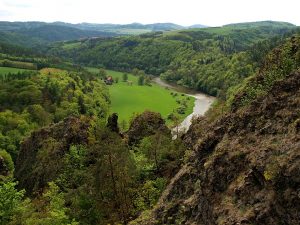Case studies
Generally speaking, a case study is one of the methods of qualitative (and quantitative) research. In a simplified way, it can be characterized as a detailed and in-depth study of one or a few cases or phenomena in a specifically selected place. It is based on the assumption that a thorough examination of one case will help to understand similar cases. At the same time, by its very nature, it does not claim statistical generalizability.
Within the One Nature Project, 3 case studies are being carried out in 3 protected areas to validate established biophysical and economic ecosystem service (ES) assessment procedures, as part of the socio-cultural ecosystem service assessment. While biophysical approaches involve modelling and indicators of ecosystem services in biophysical units, economic assessment values ecosystem services using economic valuation procedures (e.g. non-market valuation method). The socio-cultural approach seeks to understand the social (individual and group) preferences of ES, the needs and desires of actors in relation to them; it also seeks to uncover people’s emotional and ethical links to nature and landscape, and to map synergies or possible contradictions and conflicts between single ecosystem services.
One of the possible tools for socio-cultural assessment are participatory methods, quite established outside of the Czech Republic, which will be used to implement the case studies in the One Nature Project. In each of the three study sites, a series of four participatory workshops will be organised in 2021-2024 with identified actors who are potential users of the ecosystem services assessment results and also whose activities significantly influence the ES in the study sites. Two series of participatory workshops are over at the end of 2022.
The analysis and identification of actors is the first important step in the preparation of participatory workshops. In doing so, we focused our attention on the following local user groups:
– water managers, foresters, farmers
– local administration and local government
– local residents, land owners and users
– service providers in tourism
– non-governmental non-profit organisations
Of course, the participant in question does not always fit exactly into the category in question, however, this is not important.
The topic of the first round of workshops held in the spring of 2022 was participatory identification of ecosystem services and their prioritisation. The aim was to gather information on which ecosystem services are important for each group of actors and why, which ones are present in the given site and which ones are most frequently mentioned. The identification and assessment were done through the “IPBES game”, in which “players” use cards depicting the different nature benefits (i.e. ES) according to the IPBES classification to prioritise the different benefits in a given site. The most important benefit was then selected during group discussions.
The IPBES game has a dual purpose: firstly, it encourages interviewees to think about what a given ecosystem service means to them (and thus provides qualitative information), and at the same time, by evaluating the ES according to the relevant criteria, quantitative rankings can be obtained and compared with each other. Another side effect of the game is the deliberation process that is a necessary part of it.
This was followed up with a second round of participatory workshops in the autumn of 2022. Using the IPBES game, we proceeded to fill in the so-called ecosystem services matrix, in which actors expressed the extent to which the ecosystems dominant in the study area provide the selected ecosystem services (prioritised at the previous workshop). The work with the matrix provided quantitative data obtained in a participatory manner, however, we obtained qualitative data, too. In the second part, the actors then reflected on the interactions between the different ecosystem benefits, deepening their knowledge of ecosystem services while contributing to the understanding of local specificities. This matrix is also used to identify synergies and trade-offs between single services, providing the basis for a future output, i.e., a map of trade-offs and synergies.
In a participatory way, the case studies will continue in 2023 and 2024.
The case studies are being carried out in three protected landscape areas, while always covering a large part of the Natura 2000 area. They were chosen for the case studies, inter alia, because of the selected ecosystem services provided by these territories, their location in the Czech Republic or because of previous research experience in the area. Below we briefly present their physical and geographic characteristics that make them unique sites within the case studies in the One Nature Project.
Třeboňsko Protected Landscape Area
Today’s picturesque landscape around the town of Třeboň resulted primarily from different geological development of the Bohemian Massif from other parts of the region, as older rocks were washed by fresh water and covered by a thick layer of sediments. Later, the Lužnice River inscribed numerous meanders, side arms and pools overgrown with peat.
The second significant influence is human, in the form of wetland landscape cultivation and creation of an extensive system of ponds and artificial water channels, which nevertheless still contain extremely valuable natural features. The first ponds were built at the end of the 14th century, but the real renaissance of pond-making did not take place until the 16th century. Traditional pond management was not at odds with nature and led to the creation of unique pond and wetland ecosystems. This is why the Třeboň region has been declared one of the six UNESCO Biosphere Reserves.

Třeboňsko Protected Landscape Area – the system around the town of Chlum u Třeboně. Photo: Vladimír Kunc
Křivoklátsko Protected Landscape Area
It is an exceptional landscape with a large forest complex in the heart of Bohemia. The composition of forest stands is very varied, with a high proportion of natural stands. Over the millennia, the Berounka River has cut into a deep valley, whose steep slopes bear a vegetation of diverse communities. Elsewhere, on some of the peaks, we can find so-called “balds” – unstocked forest land with xerophytic grasses and shrubs. The level of species diversity here is really high: over 1800 species of vascular plants, 80 autochthonous tree species and 155 bird species. There is also wealth in the form of millions of years old fossils in the ground. Like the Třeboň region, the Křivoklát region is also a biosphere reserve. Currently, the establishment of a national park within the first zone of the Křivoklátsko Protected Landscape Area is being discussed again.

Křivoklátsko Protected Landscape Area – a view from the Čertova skála nature reserve to the valley meadows near the secluded place of Kouřimecká rybárna. Photo: Petr Hůla
Slavkovský les Protected Landscape Area (Sokolov region)
In a triangle among spa towns there is an “island of forest greenery” called Slavkovský les. It hides a diverse natural wealth in the form of extensive peat bogs, heaths, wetland and marsh meadows, unique serpentinite-related flora, mineral springs and mofettes, but there are also preserved beech forests and valleys of meandering rivers. The area is of particular importance, not least because of the rare plants associated with the unique serpentinite subsoil. It is also an area with a rich mining history. Today, there are numerous spoil heaps, which form a system of forest and non-forest ecosystems created by reclamation or spontaneous succession on the heaps of spoil that is produced as waste from mineral extraction.





